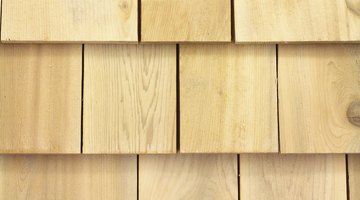How to Install Cedar Shingle Siding
Cedar shingle siding can give a home old-world charm, but that isn't the only reason to install it: The natural oils in cedar make it resistant to mold, and its open-cell structure makes it flexible and resistant to cracking.

The cell structure also creates a cushion of air inside each shingle that helps to insulate your house. Cedar shingles are treated with a fire retardant that makes them as safe to use as any other type of siding material. Installing them is more labor-intensive than installing some other types of siding, but it isn't as challenging as may appear.
Things You Will Need
- House wrap
- Window and door flashing
- Wood trim
- Level
- 1¼-inch roofing nails
- Utility knife
- Pencil
- Chalk line
-
Begin the installation by wrapping the house with a waterproof membrane -- either 15- to 30-pound felt or semi-permeable house wrap. Waterproof the window sills by covering them with flex wrap; extend the flex wrap at least 6 inches up the sides of each window opening. Install drip edge flashing along the tops of the window and door openings.
-
Install the windows and door jambs so you can trim the doors, windows and corners of the house with wood trim. The shingles butt against the trim.
-
Define the bottom line of the shingles. On most houses, that line coincides with the bottom of the wall sheathing, but if the house has a concrete foundation, the shingles may overlap the concrete by an inch or two.
-
Nail one of the shingles to the sheathing so it extends to the line, then use a level to install the rest of the shingles in that row, with their ends flush with each other. Extend this row of shingles around the house, using the level to keep the bottom edge horizontal.
-
Attach the shingles with 1¼-inch roofing nails. Drive the heads flush with the wood, but don't allow them to penetrate. Use two nails per shingle. When you come to the last space in a row, use a utility knife to cut a shingle to fit into it.
-
Use a pencil to mark the lower edge of the next row of shingles on the corner trim. It should be 5 to 8 inches above the edge of the row underneath and dependent on how much of each shingle you want to expose. Make a similar mark on the opposite corner of the wall, then stretch a chalk line between the marks and snap a line. Make marks on the other walls at the same height and snap lines on those walls.
-
Install the next row of shingles with its bottom edge flush with the chalk line. Stagger the joints between shingles from one row to the next to avoid continuous lines.
-
Work your way up the walls until you reach the soffits and must cut shingles to fit. Trim one row of shingles to maintain the proper exposure of the shingles underneath them, then install wood trim to conceal the upper edges of the last row of shingles.
Tip
Some builders like to save time by using a pneumatic staple gun to affix the shingles. If you use one, adjust the air pressure so the staples don't fully penetrate the wood. If they penetrate, the shingles may fall off.
The Drip Cap
- Cedar shingle siding can give a home old-world charm, but that isn't the only reason to install it: The natural oils in cedar make it resistant to mold, and its open-cell structure makes it flexible and resistant to cracking.
- Cedar shingles are treated with a fire retardant that makes them as safe to use as any other type of siding material.
- Install the windows and door jambs so you can trim the doors, windows and corners of the house with wood trim.
- The shingles butt against the trim.
- Define the bottom line of the shingles.
- Nail one of the shingles to the sheathing so it extends to the line, then use a level to install the rest of the shingles in that row, with their ends flush with each other.
References
Writer Bio
Chris Deziel has a bachelor's degree in physics and a master's degree in humanities. Besides having an abiding interest in popular science, Deziel has been active in the building and home design trades since 1975. As a landscape builder, he helped establish two gardening companies.
Photo Credits
- BWFolsom/iStock/Getty Images
- BWFolsom/iStock/Getty Images
More Articles



